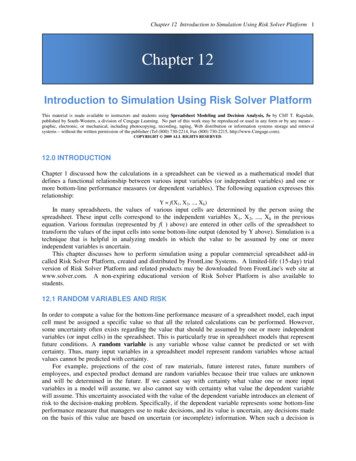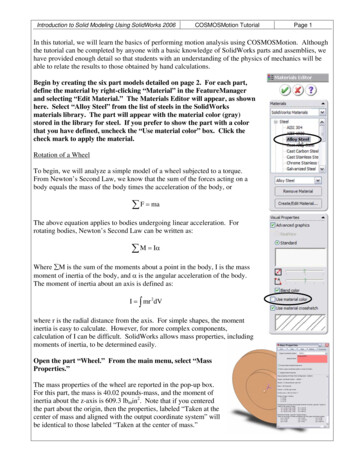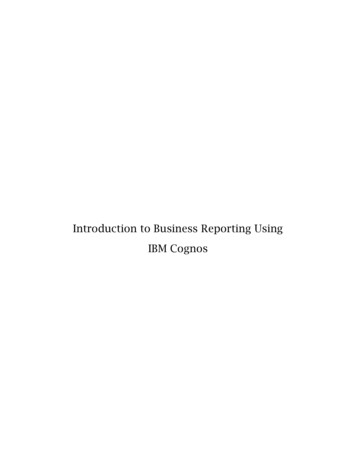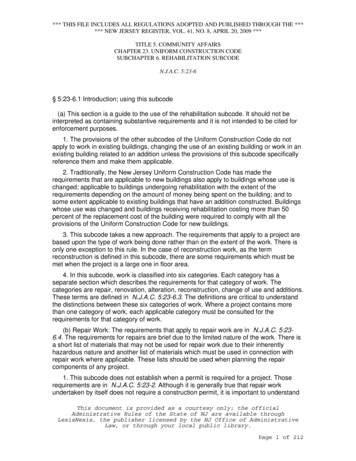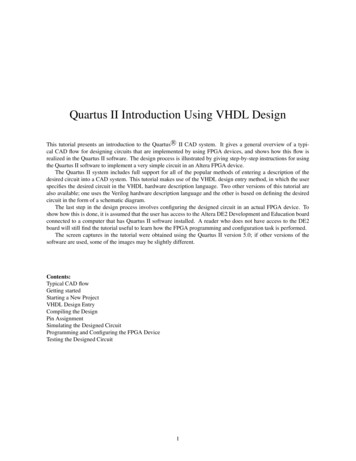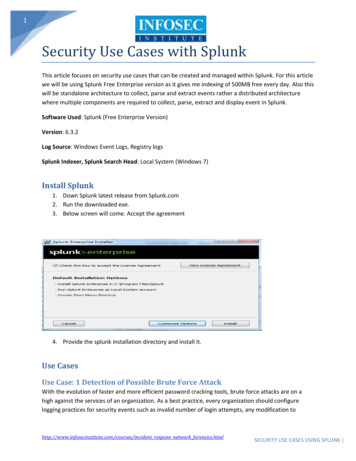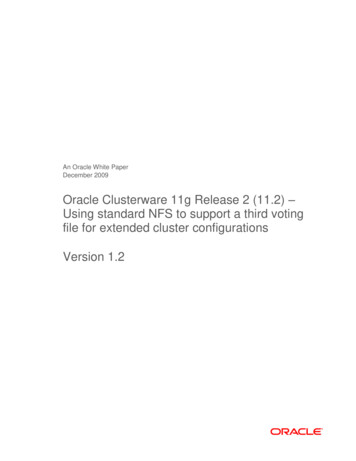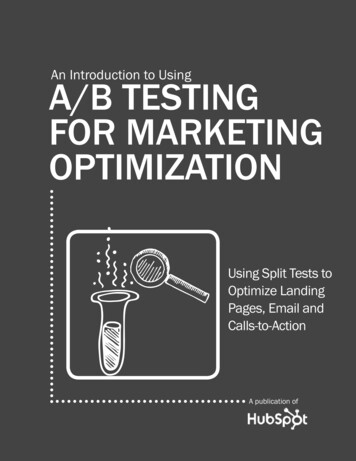
Transcription
An Introduction to Usinga/B Testingfor marketingoptimizationUsing Split Tests toOptimize LandingPages, Email andCalls-to-ActionA publication of
An introduction to a/b tesTing2An introduction to a/b testing3IS THIS BOOK RIGHT FOR ME?Not quite sure if this ebook is right for you? See the below description to determine ifyour level matches the content you are about to read.INTRODUCTORYThis ebook!Introductory content is for marketers who are new to the subject.This content typically includes step-by-step instructions on howto get started with this aspect of inbound marketing and learn itsfundamentals. After reading it, you will be able to execute basicmarketing tactics related to the topic.INTERMEDIATEIntermediate content is for marketers who are familiar with thesubject but have only basic experience in executing strategies andtactics on the topic. This content typically covers the fundamentalsand moves on to reveal more complex functions and examples.After reading it, you will feel comfortable leading projects with thisaspect of inbound marketing.ADVANCEDHubSpot’s All-in-OneMarketing Software. brings your whole marketing world together in one, powerful, integrated system.Get Found: Help prospects find you onlineConvert: Nurture your leads and drive conversionsAnalyze: Measure and improve your marketingPlus more apps and integrationsRequest A DemoVideo OverviewU qLeadGenerationblogging &social mediaM sEmail &AutomationSearchoptimizationg YLeadmanagementMarketinganalyticsAdvanced content is for marketers who are, or want to be, expertson the subject. In it, we walk you through advanced features ofthis aspect of inbound marketing and help you develop completeShare This Ebook!mastery of the subject. After reading it, you will feel ready not onlyto execute strategies and tactics, but also to teach others how toShare This Ebook!be successful.www.Hubspot.comwww.Hubspot.com
4An introduction to a/b tesTingAn introduction to using a/BTesting for marketing optimizationAn introduction to a/b testing5COntentsEdited by Magdalena Georgieva10 guidelines for effective A/B TestingMaggie Georgieva is an inbound marketingmanager at HubSpot responsible for creatingwhat Variables you should test /17new offers, including ebooks and webinars.a/b testing case studiesShe has previously helped with HubSpot’semail marketing program and the company’sis a prolific marketing blogger and has alsowww.Hubspot.com/39Conclusion & additional resources /50written for publications like BostInnovation.comShare This Ebook!/31running & evaluating your testslanding page creation and optimization. Maggieand The St. Petersburg Times./9Follow me on twitter@mgievaShare This Ebook!www.Hubspot.com
An introduction to a/b tesTing6“Why shouldI conductA/B testing?”?An introduction to a/b testing7Such increases in lead generation can provide a huge competitive advantage for your company. Infact, chances are your competitors aren’t doing A/B testing right.only 40% ofmarketers validatetest results.MarketingSherpa Landing Page OptimizationBenchmark Survey, 201160%40%A/B testing, also known as split testing, is a method of testing through which marketing variablesare compared to each other to identify the one that brings a better response rate. In this context,the element that is being testing is called “control” and the element that is argued to give a betterresult is called “treatment.”Running A/B tests in your marketing initiatives is a great way to learn how to drive more traffic to“In our ROI-driven world of digital marketing, testing without calculating statistical significance ofyour website and generate more leads from the visits you’re getting. Just a few small tweaks tothe data is not much different than not testing at all,” write MarketingSherpa in its report.a landing page, email or call-to-action can significantly affect the number of leads your companyattracts.With such an effective lead generation tool, you can easily create more opportunities for your salesteam and get ahead of your competitors. With the right software, A/B testing costs next to nothingThe insights stemming from split tests can drastically improve the conversion rates of your landingto implement. And although sometimes it’s the more complex elements that need to be revised,pages and the clickthrough rates of your website calls-to-action and email campaigns. In fact, A/Bsome of the most dramatic results come from quick and simple changes. In other words, if you’retesting of landing pages can generate up to 30-40% more leads for B2B sites and 20-25% morenot A/B testing, you’re missing out on some serious lead generation boost.leads for eCommerce sites.Share This Ebook!www.Hubspot.comShare This Ebook!www.Hubspot.com
An introduction to a/b tesTing8An introduction to a/b testing9A/B Testing or Multivariate Testing:What’s The Difference?Although these two terms are both often thrown around in the marketing world, multivariate andA/B testing are not the same thing.A/B testing allows you to only test one variable at a time. It’s usedto pick the better out of two variables. For instance, if you areA/Btestingtesting the background color of your landing pages to determinewhich one helps you generate the most conversions, you mighttest red vs. blue. You can also test on the page level, whichmeans that you are looking at the entire page as the variable.Multivariate testing, on the other hand, enables you to test manyCHAPTER 110 guidelinesfor effectiveA/B Testingvariables simultaneously. Theoretically, multivariate testingcombines a series of simultaneous A/B tests. In order to conductstatistically significant multivariate testing, you need to have a lotMultivariatetestingof traffic (the type of traffic YouTube and Google get.)This ebook covers A/B testing, but many of the practices mentioned in it can be applied tomultivariate testing as well. Let’s dive into A/B testing and start with a look at how to create aneffective A/B test and how to measure its significance.Share This Ebook!www.Hubspot.comShare This Ebook!www.Hubspot.com
An introduction to a/b tesTing10“Remember, a simple changecan drive big results.A/B testing can quickly give rise to a number ofquestions. What should you start testing? How”An introduction to a/b testing#1ONLY CONDUCT ONE TEST AT A TIMEIf you test an email campaign that directs to a landing page at the same time that you’re A/Btesting that landing page, your results can get muddled pretty easily. How would you know whichchange caused the increase in leads?As a general rule, and especially if you’re relatively new to the A/B testing method, don’t conductmultiple tests at the same time.long should the test last? Things get confusingfast.11Test One Variable at a TimeThere are certain guidelines you should keep#2in mind before you implement your tests. InIn order to evaluate how effective an element on your page, call-to-action or email campaign is,this section we will cover some best practicesyou have to isolate that variable in your A/B test. Only test one element at a time. Note that bythat will make it much easier to measure yourtaking the entire page, email or CTA as the variable, you can achieve drastic improvement.results and find out which variation performedbetter. Such knowledge will guide you in figuringout how to best optimize your landing pages,calls-to-action and email.#3test minor changes, tooAlthough it’s reasonable to think that big, sweeping changes can increase your lead generationnumbers, the small details are often just as important. While creating your tests, rememberthat even a simple change, say, switching the color of your call-to-action button, can drive bigimprovements. In fact, these sorts of changes are usually easier to measure than the bigger ones.Share This Ebook!www.Hubspot.comShare This Ebook!www.Hubspot.com
An introduction to a/b tesTing12you can a/b testthe entire elementAn introduction to a/b testing#4While you can certainly test a button color or a background shade, you should also considermaking your entire landing page, call-to-action or email a variable. Instead of testing single designelements, such as headlines and images, design two completely different pages and test them#5Measure asfar downthe funnelas possibleClickthroughrateagainst each other. Now you’re working on a higher level. This type of testing yields the biggestimprovements, so consider starting with it before you continue your optimization with smallertweaks.#513Measure as far down thefunnel as possibleConversionrateSure, your A/B test might have a positive impact on your landing page conversion rate, but howabout your sales numbers? A/B testing can have a significant effect on your bottom line. You mayeven see that a landing page that converted fewer prospects produced more sales. As you createyour A/B test, consider how it affects metrics such as clickthrough rates, leads, traffic-to-leadLeadsDemorequestsSalesconversion rates, and demo requests.Share This Ebook!www.Hubspot.comShare This Ebook!www.Hubspot.com
14An introduction to a/b tesTingset up control & treatmentAn introduction to a/b testing#6#715decide what you want to testIn any experiment, you need to keep a version of the original element you’re testing. WhenAs you optimize your landing pages, calls-to-action and email, there are a number of variables youconducting A/B tests, set up your unaltered version as your “control:” the landing page, call-to-can test. You don’t have to limit yourself to testing only color background or text size. Look at theaction or email you would normally use. From there, build variations, or “treatments:” pages, calls-various elements on your marketing resources and their possible alternatives for design, wording,to-action or email you’ll test against your control.layout.For example, if you are wondering whether including a testimonial on a landing page would make adifference, set up your control page with no testimonials. Then create your variation(s).In fact, some of the areas you can test might not be instantly recognizable. For instance, you cantest different target audiences, timing, alignment between an email and a landing page, etc. Variation A: Control (the unaltered, original version) Variation B: Treatment (the optimized version which you expect to perform better)The screenshot below is an example of HubSpot’s advanced landing pages A/B testing tool. Youcan easily clone the control and modify it to create a treatment page.split your sample group randomly#8In order to achieve conclusive results, you need to test with two or more audiences that are equal.For instance, in email A/B testing each of your email variations must have as similar a group ofrecipients as possible. List sources, list type, and the length of time a particular name has been ona list are all factors that may cause large differences in response rates. Your test results will not beconclusive or you may draw the wrong conclusions if you do not split your lists randomly.If you want to compare the performance of two or more lists, keep all other aspects of the designand timing identical so you get clean results based on list and nothing else.Share This Ebook!www.Hubspot.comShare This Ebook!www.Hubspot.com
An introduction to a/b tesTing16#917test at the same timeTiming plays a significant role in your marketing campaign’s results – be it time of day, day of theweek, or month of the year. If you were to run test A during one month and test B a month later,you wouldn’t know whether the changed response rate was a result of the different template or thedifferent month.A/B testing requires you to run the two or more variations at the same time. Without simultaneoustesting, you may be left second-guessing your results.decide on necessarysignificance before testingAn introduction to a/b testingCHAPTER 2whatVariables youshould test#10Before you launch your test, think about how significant your results should be in order for youto decide that the change should be made to your website or email campaign. Set the statisticalsignificance goal for your winning variation before you start testing. 97-99% statistical significanceis usually a good percentage to aim for.Share This Ebook!www.Hubspot.comShare This Ebook!www.Hubspot.com
An introduction to a/b tesTing18“What elements should I testand optimize?”As you build landing pages, call-to-action and email campaigns,you’ve probably wondered about the elements you can testand optimize to increase conversion rate. Should you changethe background color of the landing page? How can you modifythe language on the call-to-action to attract the most clicks?What if you removed all images from your email campaign?Not all variables are created equal, and some may prove more worthyAn introduction to a/b testing19elements that you can optimizeon a landing page:You should start your optimization process by finding what typesof offers convert the most visitors into leads and which offersoffershelp you push leads down the sales funnel.For instance, at HubSpot we have found that ebooks perform better than webinars in convertingvisitors to leads, but webinars do better than ebooks in converting leads to customers. Thathas led us to maintain a balanced mix of content. More middle-of-the-funnel offers, such asconsultations and demos, will most likely be characterized by high customer close rate.You can also test different topics and find out how they compare in driving business results.of your time than others. In fact, there are some variables you shouldn’tbother testing at all because they won’t impact clickthrough or conversionrates all that much.copyHow should you position your offer? What messagingwill entice your reader? Should you add testimonials tostrengthen the visitor’s incentive?You need to recognize the elements that you should spend most timetesting and optimizing. In this section we will review both areas that arePeople looking for information online will pay attention to the description of your offer. Considercritical and some that are less critical for lead generation.different landing page copy that can help you drive more conversions. For instance, bullet pointsand data-driven content have traditionally performed well for us, at HubSpot. Start with a radicaltest in which you compare a short, one-paragraph long description to longer but still valuable copy.Share This Ebook!www.Hubspot.comShare This Ebook!www.Hubspot.com
An introduction to a/b tesTing20FormFieldsAn introduction to a/b testingShould your lead capture form only request an emaila form or keep it form-free for all the world to see with no exchange ofinformation. Some argue that forms create frictions in the lead generationprocess, while others believe that forms are essential for qualifying trafficand prioritizing work for the sales organization.formfieldsofferaddress or should it ask for more information?Inbound marketers diverge in their decision whether to place content behind21lLanding page A/B testing enables you to evaluate how your audience reacts to different questions-what prospects are willing to answer and what information they would rather not share. Form fieldshelp you qualify leads and nurture them. (With form-free content, you have to relinquish more leadnurturing control -- you didn’t ask for their information, so how can you get back in touch with themunless they either bookmark your site?)As we mentioned earlier, taking the entire page as thevariable is the fastest way to achieve drastic results andwholepageproduce a landing page that drives a lot of conversions.Make iterations to the whole page that affect image placement, form length and its copy. Onceyou have a statistically significant result pointing to the variation that performed better, you cancontinue optimizing through smaller tweaks.Share This Ebook!www.Hubspot.comcopyimageShare This Ebook!www.Hubspot.com
An introduction to a/b tesTing22elements that you can optimizeAn introduction to a/b testing23There has been a huge debate revolving around usagein a call-to-action:of the color red for call-to-action design. Some graphicdesigners argue that red can increase clickthroughcolorrates significantly. Others explain that the context ofplacementAccording to an Eyetrack III study, the best placementthe web page should determine the color.of online ads is in the top and left position. That makessense: in the English language, we start reading fromWhen running A/B tests to determine the highest converting color, be mindful of your overallleft to right and from top to bottom.website design. While you want to keep the colors contrasting, make sure all of them fit in withyour general website color scheme and avoid using patterns.However, copywriter Dean Rieck suggests that once your readers get used to a particularplacement, they might start ignoring the call-to-action or ad. “So even the prime upper left areawon’t work so well if you always put ads there,” Rieck writes. The most effective placementcopycould also depend on the context of the rest of the page, so make sure you do some testing. Forinstance, test the ideal top and left position versus a placement in which the call-to-action is rightbeneath the offer description. Run an A/B test to see if you get more clicks and pick a winner.Size is tightly related to the context of the page and the othercharacteristics of your call-to-action. For instance, the CTAThe Eyetrack III study also showed that in ads, websitevisitors read more text content than graphical content.“People looking for information are looking for text, not pictures,” writes Dean. Make sure yourwording is clear, specific, and action-oriented. Do some testing to figure out what text will makevisitors more likely to click. If you need more guidance on copywriting for calls-to-action, downloadsizeour free ebook, which includes some specific tips and examples.will naturally be large if it includes a graphic or an image thatstrengthens the message. Create an A/B test to see if a big callto-action that adds value to the message--e.g. a customized blogCTA--attracts more clicks than its control.While you should focus on your call-to-action text, don’tforget that graphics can help convey meaning andgraphicstrengthen your message. Experiment with various shapesbesides the standard button-like form and test how thenew look affects your clickthrough rate.Share This Ebook!www.Hubspot.comShare This Ebook!www.Hubspot.com
An introduction to a/b tesTing24graphicplacementAn introduction to a/b testing25elements that you can optimizein your email:sizeYou must have noticed that many of the elements to test andoptimize we have discussed so far overlap across differentchannels. Offers, copy and image are certainly some of thevariables you want to always keep in mind. They apply to emailmarketing as well, so we won’t repeat them here but discuss thefew new ones we haven’t mentioned so far.MWhat’s the best way to lay out your email content toformatdrive the most engagement? Should your message bestructured as a newsletter, digest or a dedicated send?A/B testing can help you determine the right format of your email marketing campaigns. Forinstance, newsletters can perform well in spreading the news about a few different pieces ofinformation, such as events, new offers, discounts and event product announcements. Dedicatedsends, on the other hand, can help you drive the most conversions to one call-to-action. Run anA/B test to determine which format yields the results you seek to achieve.offercopycolorSimilar to testing formats, layout is another element that youcan test and optimize for on an ongoing basis. Experimentlayoutwith different image and call-to-action placement and watchnot only your clickthrough rates, but also your conversions toShare This Ebook!www.Hubspot.comdetermine which layout is most effective.Share This Ebook!www.Hubspot.com
An introduction to a/b tesTing26An introduction to a/b testing27A/B email marketing tests that we ran at HubSpot intimingOur Science of Timing research shows that the most2011 showed that messages coming from a personalclicks on email are seen on the weekend.sender name receive higher CTR rate than messagessenderfrom a generic sender name.So if you have been traditionally afraid of emailing on Saturdays and Sundays, it’s time toSo instead of sending emails from Marketing Team, we started making the senders of ourreconsider this practice and experiment with your timing.Effect of Day-of-Week on Clickthrough Ratemarketing emails be the real experts from our team. To reinforce this personalization and createconsistency, we have been adding the person’s signature at the end of the message.Personalization is a well-known best practice in email marketing but you should still test sendernames with your audience. Ensure that a change like this yields positive results for your companybefore you implement it.subjectlinesSubject lines are the part of emails that can grab yourrecipients’ attention immediately and convince them to openthe email and read more. So you really want to get them right.SundayMondayTuesdayWednesday ThursdayFridaySaturdayInterestingly enough, subject lines are the part marketers seem to be testing the most aboutemail. In MarketingSherpa’s Email Marketing Benchmark survey of 2,735 professionals 72% ofNaturally, the optimal timing for sending marketing emails will vary by industry and even company.respondents said that they run A/B tests to determine a winning subject line. Yet only 35% find theShould your prospect be sent your next email one hour later or one day later? Identify the best timetests effective.to convert prospects into leads by running split tests.If you decide on testing email subject lines, try to deduct a lesson from your experiment. Is it thelength of the subject line, mention of a discount or certain formatting (e.g., brackets or colon) thatShare This Ebook!www.Hubspot.commade the difference?Share This Ebook!www.Hubspot.com
An introduction to a/b tesTing28Who are you sending email to? Segmentation can help youAn introduction to a/b testingtargetgroupget high response rates because your recipients will find themessages particularly valuable.sender29timingsubjectThat will also increase the chances of them sharing your email with friends and coworkers. Infact, MarketingSherpa’s survey shows that marketers find testing target audiences to be a prettyeffective a Email Marketing Benchmark SurveySurvey Methodology: Fielded July 2011, N geShare This tlayoutShare This Ebook!www.Hubspot.com
An introduction to a/b tesTing30An introduction to a/b testing31elements you shouldn’tbother testing:So far we’ve discussed some variables that you can test in orderto optimize the performance of different marketing activities.However, A/B testing is time-consuming and you need to besmart about the elements you decide to optimize. Some of themdon’t deserve your time.Minor Text ChangesdIf you’re going to change your headline or subject line, change it drastically. TheCHAPTER 3a/b testingcase studiespositioning and the content of your copy matter, but switching “The” to “A” isn’t going tomake any sort of difference.general ImprovementsIf you know that something is an improvement, like a mobile-friendly email, there is nopoint in testing it to see how it compares to an email that is not optimized for mobileviewing. The switch certainly won’t hurt your marketing!Share This Ebook!www.Hubspot.comShare This Ebook!www.Hubspot.comwww.Hubspot.com
An introduction to a/b tesTing32“Learn from real-life A/Btesting examples below.”Now that we have covered some suggestions onelements that you can test and optimize, you’d probablylike to see how these tests might look like. What aresome real-life examples of A/B testing in action?An introduction to a/b testing33an example ofa landing page test:This test was produced for the 2011 Landing Page Optimization Summit held by MECLABS, theparent company of MarketingSherpa & MarketingExperiments. HubSpot was part of a live landingpage optimization test in which the audience was given a control page and was asked to build atreatment page by incorporating changes that would positively affect conversion rates.Here is a screenshot of the control page:controlIn this section of the ebook we cover three A/B tests across different marketing channels. Weexplore what a split test for a landing page, call-to-action and email looks like. All of the examplesthat we discuss here have been conducted by members of the HubSpot marketing team and eachtest can teach you a lesson on A/B testing. More specifically, our three case studies covered hereadvise you to:optimize landing pages that don’t convert at a high ratestart your optimization process with an offer testuse the knowledge you’ve gained to improve existing processesShare This Ebook!www.Hubspot.comShare This Ebook!www.Hubspot.com
34An introduction to a/b tesTingThe entire page was taken as a variable and was revamped. We changed the image and itsplacement and shortened the copy and the form. In an effort to drive a lot of traffic to this page, wedid a heavy email marketing push, blog posts and social media promotion. The test was conductedAn introduction to a/b testing35an example ofa call-to-action test:using HubSpot’s landing page tools.The screenshot below is of a call-to-action A/B test that sought to compare two offer types. Theimage actually illustrates what HubSpot’s homepage used to look like in 2010!Originally, HubSpot’s homepage offered our community a seven-day free trial. However, we werecurious to see if offering a longer trial period would entice more visitors to sign up. Would it have asignificant enough effect? In this case our control was a variation that offered the seven-day freetrial and the treatment offered a 30-day free trial.controltreatmentOur A/B test results showed that the control converted at a rate of 47.91% and the treatmentconverted at a rate of 48.24%, an absolute difference of 0.3% which is a pretty negligible increase.The conclusion we arrived at is that the audience was highly motivated by the offer itself. So whenrunning A/B tests, start with pages that have a low visitor-to-lead conversion rate. It’s pretty hard tobeat a page that converts 47% of the traffic.Share This Ebook!www.Hubspot.comShare This Ebook!www.Hubspot.com
An introduction to a/b tesTing36Results from the test showed that the 30-day free trial enticed more visitors and had a significanteffect on conversion rates. The 30-Day free trial won with a 99.9% confidence rate and created a110% increase in HubSpot free trials. The control had a 0.326% visitor-to-free-trial conversion rate,while the treatment had a 0.709% visitor-to-trial conversion rate.An introduction to a/b testing37an example ofan email test:Subject lines are a critical element of email marketing. They have the power to grab the attentionof recipients and impact clickthrough rates to a great extent. That is why we always want to makesure that we are using the right subject line when we are emailing our subscribers. We regularlytreatmentconduct A/B tests to evaluate winning subject lines.But besides a subject line, recipients also see a sender name in their inbox. Who is the emailcoming from? This sender name can make a difference on open and clickthrough rates. So in2011 we conducted a test to compare a generic “HubSpot” sender name to a personal name fromsomeone on the marketing team.8.00%7.10%7.00%The takeaway emerging from this A/B test is that type of offer can exercise a tremendous influenceover lead generation efforts. If you want to optimize your calls-to-action (and for that matter emailand landing pages), comparing different offers is a great place to start. Such experiments willprovide you with a better understanding of what prompts your visitors to convert into leads.“Type of offer can exercise atremendous influence over leadgeneration efforts.Share This Ebook!www.Hubspot.com”6.57%Control - From “HubSpot” sender name6.00%Treatment - From “Maggie Georgieva,5.00%HubSpot” sender name4.00%3.00%2.00%0.96%0.73%1.00%0.00%Open RateFrom "HubSpot"Share This Ebook!Click Through RateFrom "Maggie Georgieva, HubSpot"www.Hubspot.com
38An introduction to a/b tesTingAn introduction to a/b testing39Our control had a 0.73% CTR and the treatment had a 0.96% CTR. With a confidence of 99.9%we had a clear winner. Our conclusion after this A/B test was that email sent by a real personare more likely to be clicked on than email sent from the company. So how does CTR impact ournumber of leads generated?The treatment got 292 more clicks than the control. Since our average visitor-to-lead conversionrate on landing pages is 45%, that means the treatment got us 131 more leads. That is great byitself but think about how valuable this lesson is when applied to our broader email marketingprogram. We took this insight and used it for the revamping of our lead nurturing campaigns,adding a personal sender name and signature to each of our messages. When your A/B tests leadto some significant results, use the knowledge you’ve gained to improve existing processes.Share This Ebook!www.Hubspot.comCHAPTER 4running &evaluatingyour testsShare This Ebook!www.Hubspot.comwww.Hubspot.com
An introduction to a/b tesTing40“Let’s look into how you can conductactual split tests.”An introduction to a/b testing41how to do conducta landing page test:With landing page A/B testing you have one URL and two or more versions of the page. When yousend traffic to that URL, visitors will be randomly sent to one of your variations. Standard landingpage A/B testing tools remember which page the reader landed on and will keep showing thatpage to
TesTing for markeTing opTimizaTion Edited by magdalena georgieva maggie georgieva is an inbound marketing manager at HubSpot responsible for creating new offers, including ebooks and webinars. She has previously helped with HubSpot’s email marketing program and the
